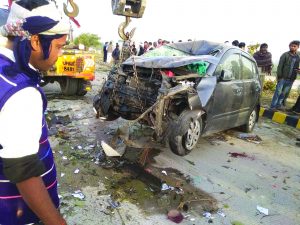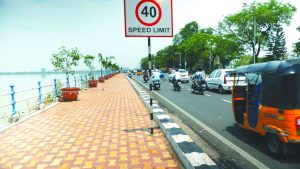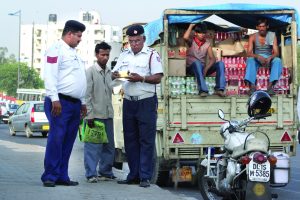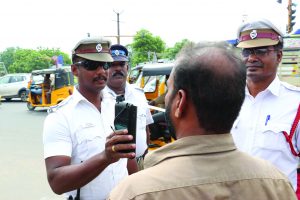 A road accident occurs almost every minute in India makes it scary to be behind the wheels particularly for children and young adults. The number of vehicles in the country has quadrupled but many of the vehicles lack basic safety necessities like seatbelts, balloons and the roads are in major need of repair. These driving conditions should make the country a contender for one of the most dangerous places in the world as for as road safety is concerned.
A road accident occurs almost every minute in India makes it scary to be behind the wheels particularly for children and young adults. The number of vehicles in the country has quadrupled but many of the vehicles lack basic safety necessities like seatbelts, balloons and the roads are in major need of repair. These driving conditions should make the country a contender for one of the most dangerous places in the world as for as road safety is concerned.
The International Road Federation (IRF) in its latest report released on November 2019 found that over 1.5 lakh deaths were recorded from India during 2018. The International Road Federation is a global not-for-profit organization, headquartered in Washington, DC since 1948 and serves a network of public and private sector members in more than 70 countries offering best practices and solutions.
 With more than 1.5 million deaths last year, India has become the unsafe country across the globe for road users. In fact with this alarming figure, India is even way ahead of China, which reported about 63,000 deaths during the whole 2018. The United States of America accounted for about 37,000 deaths on roads. The Geneva-based International Road Federation (IRF) has found that India is table topper in terms of road deaths across globe.
With more than 1.5 million deaths last year, India has become the unsafe country across the globe for road users. In fact with this alarming figure, India is even way ahead of China, which reported about 63,000 deaths during the whole 2018. The United States of America accounted for about 37,000 deaths on roads. The Geneva-based International Road Federation (IRF) has found that India is table topper in terms of road deaths across globe.
Ninety-per cent of road traffic deaths occur in low-and middle-income countries, and while these countries also account for 82 per cent of the world’s population, they nevertheless bear a disproportionate number of deaths relative to their level of motorization, as they account for only 54 per cent of the world’s registered vehicles. While absolute numbers of deaths are important in terms of seeing where road traffic deaths are occurring and being able to target efforts to prevent them, a more useful indicator is to compare the risk of dying as the result of a road traffic crash using rates per 100,000 population.
While the global rate for road traffic deaths is 17.4 per 100 000, there is great disparity by income, with rates more than twice as high in low- and middle-income countries than in the world’s high income countries. This report shows that 68 countries have seen a rise in the number of road traffic deaths since 2010, of which 84 per cent are low- or middle-income countries.
Almost half of all deaths on the world’s roads are among those with the least protection — motorcyclists, cyclists and pedestrians. More attention must be given to the needs of pedestrians and cyclists Making walking and cycling safer is critical to reducing the number of road traffic deaths and is important for achieving the Decade of Action for Road Safety’s aim to promote non motorized forms of transport. Similarly, motorcyclist safety must be prioritized too. Globally, nearly a quarter of all road traffic deaths are among motorcyclists. The use of motorcycles is much higher in Asian countries than elsewhere.
Coming to different states in India, according to annual report of the Union Ministry of Road Transport and Highways in 2018, the top three were Uttar Pradesh (22,256), Maharashtra (13,261) and Tamil Nadu (12,216). The Union Ministry of Road Transport and Highways has in its report has observed that road safety is a complex issue of concern, considering its
magnitude and gravity and the negative impacts on the economy, public health and the general welfare of the people, particularly those with low income.
With rising motorization at 10 per cent compound growth every year and expanding road network, travel risks and traffic exposure grow at a much faster rate and as such road traffic injuries are one of the leading causes of deaths, disabilities and hospitalizations, with severe socioeconomic costs. The Government has approved a National Road Safety Policy that outlines various policy measures such as promoting awareness, establishing road safety information data base, encouraging safer road infrastructure including application of intelligent transport, enforcement of safety laws etc.
Children, youth & poor most hit
Since 55 years, the International Road Federation statistics continue to be the major comprehensive, universal source of statistical data on road networks, traffic and inland transport, including traffic accidents. This year the World Road Statistics (WRS) data features 205 countries. The report suggests that road traffic injuries claim more than 1.3 million lives each year and have a huge impact on health and development.
They are the leading cause of death among young people aged between 15 and 29 years, and cost governments approximately 3 per cent of GDP. With more than 1.3 million people die each year on the world’s roads, making road traffic injuries a leading cause of death globally. Most of these deaths are in low- and middle-income countries where rapid economic growth has been accompanied by increased motorization and road traffic injuries. As well as being a public health problem, road traffic injuries are a development issue: low- and middle-income countries lose approximately 3 per cent of GDP as a result of road traffic crashes. Despite this massive — and largely preventable — human and economic toll, action to combat this global challenge has been insufficient.
This report on road safety shows that low and middle-income countries are hardest hit, with double the fatality rates of high-income countries and 90 per cent of global road traffic deaths. Vulnerable road users — pedestrians, cyclists and motorcyclists — make up half of these fatalities. Commendable national efforts have taken place against the backdrop of the Decade of Action for Road Safety 2011–2020, a global framework guiding national-level action across a number of areas relevant to road safety.
In addition to the Decade of Action, international attention to the urgency of road safety has increased recently with the adoption of the 2030 Agenda for Sustainable Development. Setting a goal of reducing road traffic deaths and injuries by 50 per cent by 2020, as part of this agenda is a reflection of the growing recognition of the contribution of road safety to health, development and broader environmental objectives, and the potential for action.
While a plateau in numbers is a welcome first step in the fight to reduce road traffic deaths, it is insufficient. In the past three years there has been a 16 per cent increase in the number of vehicles on the world’s roads. Set against this inexorable rise, much more must be done to stop the death and destruction on the world’s roads and to achieve the ambitious target for road safety set out in the Sustainable Development Goals (SDGs). The report highlights that across many measures, countries have not done enough to implement what we know works.
The report finds fault with speed management, which lies at the heart of an effective approach to reducing deaths and injuries, is notably poor in many countries. Then vehicles sold in the majority of the world’s countries do not meet minimum safety standards while roads continue to be designed and built without sufficient attention to the needs of the most vulnerable road users. While much progress has been achieved over the past decade, the pace has been too slow. The target of a 50 per cent reduction in road traffic deaths and injuries by 2020 offers a powerful focus around which governments and the international community can galvanize action.
The report highlights that the situation is worst in low-income countries, where rates are more than double than those in high-income countries and there are a disproportionate number of deaths relative to the lower level of motorization. The report finds that many high-income countries have been very successful at achieving and sustaining reductions in death rates despite increasing motorization. Changing road user behaviour is a critical component of the holistic “Safe Systems” approach advocated in this report.
Adopting and enforcing good laws is effective in changing of road user behaviour on key risk factors for road traffic injuries — speed, drink — driving, and the failure to use helmets, seat-belts and child restraints properly or at all. The report highlights that 17 countries have changed laws to bring their legislation on one or more of these five risk factors into line with best practice in the past three years. This represents 409 million people or 5.7 per cent of the world’s population.
The situation is most advanced on seat-belt laws, where 105 countries, representing 67 per cent of the world’s population, now have laws that meet best practice. While the report highlights encouraging examples of countries that have brought their laws into line with best practice on particular risk factors, the potential for appropriate road safety laws to reduce road traffic deaths is largely unmet at a global level.
Target to halve deaths
 India is a signatory to the 2015 Brasilia declaration, under which it vowed to reduce the number of road accidents and deaths to half by 2020. This goal looks improbable, as the annual death toll has hovered around the 1.5 lakh mark in recent years. Hosted by the Government of Brazil on 18-19 November 2015 in Brasilia, Brazil, and co-sponsored by WHO, the 2nd Global High-Level Conference on Road Safety represented a historic opportunity to chart progress at the mid-point of the Decade of Action for Road Safety 2011-2020. At the close of the Conference, the 2200 delegates including from India adopted the “Brasilia Declaration on Road Safety” through which they agreed ways to halve road traffic deaths by the end of this decade — a key milestone within the new Sustainable Development Goal.
India is a signatory to the 2015 Brasilia declaration, under which it vowed to reduce the number of road accidents and deaths to half by 2020. This goal looks improbable, as the annual death toll has hovered around the 1.5 lakh mark in recent years. Hosted by the Government of Brazil on 18-19 November 2015 in Brasilia, Brazil, and co-sponsored by WHO, the 2nd Global High-Level Conference on Road Safety represented a historic opportunity to chart progress at the mid-point of the Decade of Action for Road Safety 2011-2020. At the close of the Conference, the 2200 delegates including from India adopted the “Brasilia Declaration on Road Safety” through which they agreed ways to halve road traffic deaths by the end of this decade — a key milestone within the new Sustainable Development Goal.
Reducing speed
 An adult pedestrian has less than a 20 per cent chance of dying if struck by a car at less than 50 km/h but almost a 60 per cent risk of dying if hit at 80 km/h. Speed is a critical risk factor for road traffic injuries. As average traffic speed increases, so too does the likelihood of a crash. If a crash does happen, the risk of death and serious injury is greater at higher speeds, especially for pedestrians, cyclists and motorcyclists. Male and young drivers are more likely to speed, while other factors likely to influence speed include alcohol, road layout, traffic density and weather conditions.
An adult pedestrian has less than a 20 per cent chance of dying if struck by a car at less than 50 km/h but almost a 60 per cent risk of dying if hit at 80 km/h. Speed is a critical risk factor for road traffic injuries. As average traffic speed increases, so too does the likelihood of a crash. If a crash does happen, the risk of death and serious injury is greater at higher speeds, especially for pedestrians, cyclists and motorcyclists. Male and young drivers are more likely to speed, while other factors likely to influence speed include alcohol, road layout, traffic density and weather conditions.
Within this framework, the speed limit where a motorized traffic mixes with pedestrians, cyclists, and moped riders, the speed limit must be under 30 km/h. This is due to the vulnerability of these road users at increasing speed: an adult pedestrian has less than a 20 per cent chance of dying if struck by a car at less than 50 km/h but almost a 60 per cent risk of dying if hit at 80 km/h.
The type of crash that is likely in a particular situation is also an indicator for determining a safe speed. For example, on roads where front impacts with other road users are possible a “safe speed” will be lower than on motorways, where head on collisions crashes are unlikely. National speed limits are crucial for effective speed management. Setting and enforcing national speed limits is an important step in reducing speed. Most countries set a limited number of general national speed limits.
Of the 205 participating countries, 97 set maximum urban speed limits of less than or equal to 50 km/h, in line with best practice. Although the definition of urban may vary between countries, given that these areas usually involve a high concentration of pedestrians and cyclists, speeds above 50 km/h would be unsafe. It is important that local authorities not only have the legal authority to reduce national limits, but also to manage local speeds according to particular road situations and in conjunction with other traffic calming or speed management policies. Such legal authority may be spelled out within the road traffic act itself, or in regulations, decrees or other legal documents beyond those relating to road traffic.
Seat belts
Seat-belts limit the movement of vehicle occupants in the event of a crash, dispersing the force of the restraint to reduce the likelihood of serious or fatal injury. They work as part of the wider occupant restraint system that includes airbags, seats, head rests and the vehicle structure itself. Wearing a seat belt reduces the risk of a fatality among drivers and front-seat occupants by 45–50 per cent, and the risk of minor and serious injuries by 20 per cent and 45 per cent respectively. Among rear seat occupants seat belts reduce fatal and serious injuries by 25 per cent and minor injuries by up to 75 per cent. Wearing a seat belt also significantly
decreases the risk of being thrown from the vehicle in the event of a crash.
Seat-belts and child restraints are extremely effective at saving the lives of car occupants in the event of a crash. Ensuring that vehicle manufacturers fit seat-belts and the fixtures necessary for child restraints is therefore critical to reducing road traffic fatalities.
Improving road infra
The IRF report had highlighted the important role of safe infrastructure and safe vehicles in reducing road traffic injuries. Road infrastructure is mainly constructed with the needs of motorists in mind, although the report indicates that 49 per cent of all road traffic deaths occur among pedestrians, cyclists and motorcyclists. Real, sustained successes at reducing global road traffic deaths will only happen when road design takes into consideration the needs of all road users.
Making walking and cycling safer is also important to support other moves to reduce carbon emissions and increase physical activity. While vehicles in high-income countries are increasingly safe, the report provides worrying data showing that less than half of countries implement minimum standards on vehicle safety, and that these standards are notably absent in many of the large middle income countries that are major car manufacturers.
Emergency care
 Lack of emergency care and gross disparities in injury outcomes between high-income countries and low- and middle-income countries explains why India accounts for most accident deaths. This directly relates to the level of care received immediately post-crash, and later in a health-care facility. Some estimate that if trauma care systems for seriously injured patients in low and middle-income countries could be brought up to the levels of high performing countries, an estimated half a million lives could be saved each year.
Lack of emergency care and gross disparities in injury outcomes between high-income countries and low- and middle-income countries explains why India accounts for most accident deaths. This directly relates to the level of care received immediately post-crash, and later in a health-care facility. Some estimate that if trauma care systems for seriously injured patients in low and middle-income countries could be brought up to the levels of high performing countries, an estimated half a million lives could be saved each year.
Quality of care at scene of the crash too matters a lot. In high-income countries, delivering emergency care at the scene of the collision and getting crash victims quickly to a health-care facility is often performed by professionally trained providers using sophisticated equipment and designated vehicles. However, in low-income countries, lay people such as community leaders, police, or taxi drivers who are trained in basic injury care and the coordination of transportation to a health-care facility can also fulfill these roles.
The most efficient way to activate an emergency response is through a universal, centralized access number with central dispatch. However, when universal access numbers are unavailable (under development or during disasters), partial measures to facilitate access include simple mechanisms to advise patients on the nearest facility and transport options.
Now 116 countries have a universal access number to activate emergency service response. as public broadcasts, mobile phone applications, electronic billboards or other mechanisms that provide real-time updates on available care resources. Health-care staff must be trained in emergency care. A systematic clinical approach to the management of road traffic victim’s injuries can improve outcomes.
The report finds that hospitals in low- and middle income countries are often staffed by general practitioners and nurses who treat a high volume of trauma patients every day, frequently without the support of dedicated trauma care training. Implementing accredited courses on trauma care for doctors and nurses in hospitals receiving a high-volume of trauma victims is an effective way of improving this care.
Preventing head injuries
Preventing motorcyclist head injuries is becoming increasingly urgent as motorcycle use rises. Data collected for this report shows that there was a 27 per cent growth in the number of motorized two-wheelers globally during the last three years. Motorcycles form a high proportion of vehicle fleets in many low- and middle-income countries, and motorcyclists comprise a large proportion of those injured or killed on the roads.
While in high-income countries motorcycle deaths typically comprise about 12 per cent of overall traffic deaths, in middle-income countries this more than doubles to 26 per cent. Motorcyclists are at an increased risk because they often share the traffic space with fast-moving cars, buses and trucks, and because they are less visible. In addition, their lack of physical protection makes them vulnerable to injury.
Injuries to the head and neck are the main cause of death, severe injury and disability among motorcyclists. The social costs of head injuries for survivors, their families and communities are high, in part because they frequently require specialized or long-term care. Head injuries also result in much higher medical costs. Increasing motorcycle helmet use these injuries can exert a high toll on a country’s health care costs and its economy.
Wearing a motorcycle helmet can reduce the risk of death by almost 40 per cent and the risk of severe injury by approximately 70 per cent. Effective enforcement of motorcycle helmet laws can increase helmet-wearing rates and thereby reduce head injuries (28). Helmet laws should cover all riders and specify a helmet quality standard. While 169 countries have a national law requiring the use of helmets among motorcyclists, there are a large number of countries where loopholes in these laws potentially limit their effectiveness.
For example, of the 169 countries that have a helmet law, only 151 stipulate that the law applies to drivers and passengers, all road types and all engine types. Furthermore, only 74 of the 169 countries (41 per cent of countries responding to the survey) explicitly state that the helmet needs to be correctly worn (i.e. properly fastened with the chin strap) in order to meet the law. Only 70 countries have national helmet laws that apply to all drivers and passengers, all road types and all engines types, and require the helmet to be properly fastened. Helmets must be of good quality to be effective and there is need for national helmet legislation. Children legally allowed, as motorcycle passengers must be required to wear a helmet.
Drunken driving
 Laws based on blood alcohol concentration (BAC) limits can reduce road traffic crashes. Drink–driving increases the chance of a road traffic crash, as well as the likelihood that death or serious injury will result. The risk of impairment starts at very low levels of alcohol consumption and rises exponentially with alcohol intake.
Laws based on blood alcohol concentration (BAC) limits can reduce road traffic crashes. Drink–driving increases the chance of a road traffic crash, as well as the likelihood that death or serious injury will result. The risk of impairment starts at very low levels of alcohol consumption and rises exponentially with alcohol intake.
The report suggested that drivers with a BAC of between 0.02 g/dl and 0.05 g/dl have at least a three times greater risk of dying in a vehicle crash. This risk increases to at least six times with a BAC between 0.05 g/dl and 0.08 g/dl, and rises exponentially above 0.08 g/dl (31). Drinking and driving is also associated with other high-risk road use behaviours such as speeding or not using seat belts. Young and novice drivers are at a much-increased risk of road traffic crashes when under the influence of alcohol compared to older and more experienced drivers.
Multifaceted approach
A multifaceted approach is required for the most effective and long-lasting changes to be made to national road safety. Such changes have been achieved in a number of high performing countries that have taken on the Safe System approach, and have seen reductions in road traffic deaths and injuries despite increasing motorization. The challenge today is for the downward trends in road traffic deaths seen in these countries to be replicated in other countries like India.
Political will is crucial to driving such changes, but this report shows that action is particularly necessary on a number of specific issues. Changing road user behavior is a key component of the Safe Systems approach. Setting and enforcing good laws relating to key behavioural risk factors can be effective at realizing such change. Although some progress has been made over the past three years with 17 countries (representing 5.7 per cent of the world’s population) improving legislation on key risk factors, many countries lag far behind in terms of making sure their laws are in line with best practice.
Lack of enforcement frequently undermines the potential of road safety laws to reduce injuries and deaths. Social marketing campaigns need to be conducted to support and maximize the effects of enforcement. Insufficient attention has been paid to the needs of pedestrians, cyclists and motorcyclists, who together make up 49 per cent of all global road traffic deaths.
Making the world’s roads safer will not be possible unless the needs of these road users are considered in all approaches to road safety — including the way roads are built and the way vehicles are manufactured. Making walking and cycling safer will also have other positive co-benefits if these non-motorized forms of transport become more popular, including more physical exercise, reduced emissions, and the health benefits associated with such changes.
Enforcement vital
Enforcement is vital to the success of road safety laws. While there is clear evidence that enforcement is critical to the success of laws, the levels of enforcement required for maximum impact are often less readily available and depend on factors such as political will, available resources and competing priorities at a national level. In countries where legislation has not previously been accompanied by enforcement, particularly visible and high levels of enforcement may be needed to persuade the public that breaking the law in future may well result in a penalty.
Furthermore, while some countries have dedicated traffic police, in many countries the cadre of police officers who are in charge of enforcing road safety laws have many other responsibilities, and their focus on traffic law enforcement can quickly slip down the priority list when faced with other pressing concerns, such as national security. Poor enforcement of traffic laws and regulations can also result from inadequate resources, administrative problems and corruption, all of which can restrict good laws in achieving their potential.
letters@tehelka.com













